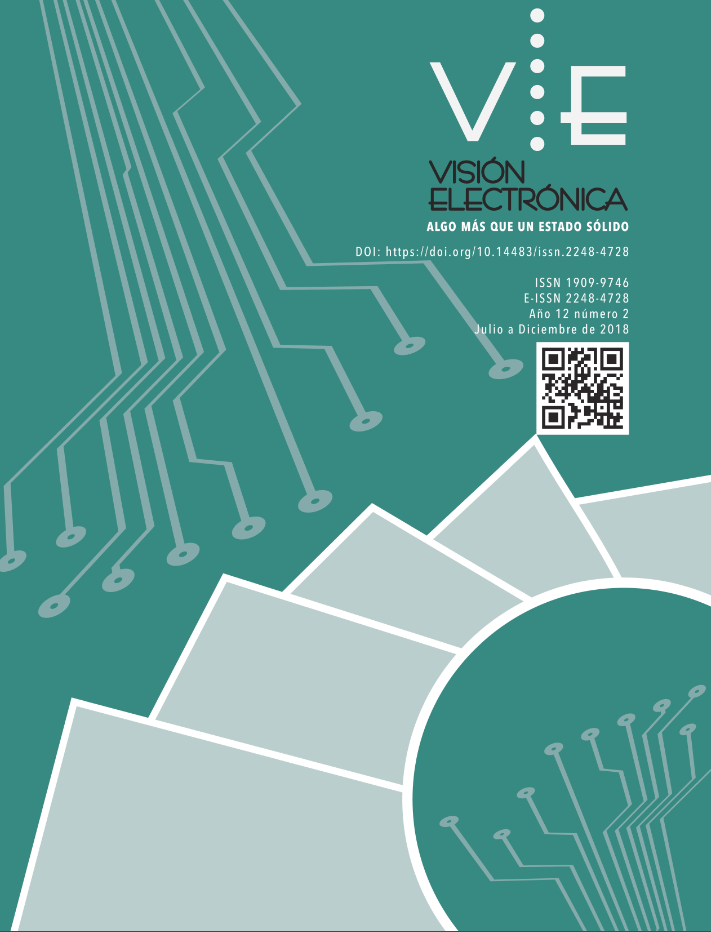DOI:
https://doi.org/10.14483/22484728.14764Publicado:
2018-10-27Número:
Vol. 12 Núm. 2 (2018)Sección:
Visión de CasoSimulación de la presión plantar en adultos mayores
Simulation of the plantar pressure in elderly people
Palabras clave:
elder, finite elements, human march, plantar pressure (en).Palabras clave:
adulto mayor, elementos finitos, marcha humana, presión plantar (es).Descargas
Resumen (es)
Comprender el comportamiento de la presión plantar en adultos mayores y los factores que influyan sobre la misma es de interés considerando el acelerado envejecimiento de la población. En este trabajo se realizó una simulación 3D del pie humano durante la marcha utilizando el método de los elementos finitos, para el estudio se utilizaron los datos de varios adultos mayores, el promedio nacional de adultos mayores y un individuo joven como control. Se obtuvo la presión pico y el área de contacto, encontrando que existen parámetros intrínsecos que modifican la huella plantar en un adulto mayor, como el peso y la estatura, a mayor peso mayor presión pico, y a mayor estatura menor región de contacto. Los hombres presentan mayor área de contacto durante la marcha que las mujeres. Este estudio encontró valores de presión pico promedio en los adultos mayores, 7,325 ± 3,97 psi en la fase de apoyo de talón, 14,25 ± 1,60 psi en la fase de transferencia de carga y 16 ± 7,77 psi en la fase de despegue de talón.
Resumen (en)
To understand the behavior of the plantar pressure in elderly people, and the factors that influence on it, this is of interest to several researchers, due to the accelerated aging of the population and the consequences that this phenomenon carries. In this work, a simulation in 3D of the human foot has been done during the march, using the finite elements method. This study used the data of several elders, the national average of elders and a young individual as control. The peak pressure and the contact area were obtained, finding the existence of intrinsic parameters which modified the footprint of an elder, such as the weight and height; the greater weight, the greater peak pressure, and the greater height, the lower contact region. Men, unlike women, present the major contact area during the march. This study found values of average peak pressure in elders, 7,325 ± 3,97 psi in the heel support stage, 14,25 ± 1,60 psi in the charge transference stage and 16 ± 7,77 psi in the takeoff stage of the heel.
Referencias
[2] E. Salas, “El Adulto Mayor y las Problemáticas Derivadas, un desafío para la educación” [En línea] Disponible en: https://www.gerontologia.uchile.cl/docs/emma_1.htm
[3] Ministerio de la Protección Social. “Diagnóstico preliminar sobre personas mayores, dependencia y servicios sociales en Colombia” [En línea] Disponible en: https://www.minsalud.gov.co/proteccionsocial/Documents/Situacion%20Actual%20de%20las%20Personas%20adultas%20mayores.pdf
[4] C. Ballesteros, E. Escobar y L. Castro, “Guía para la prevención de accidentes en las personas mayores”. [En línea] Disponible en: http://www.madrid.org/cs/Satellite?lobcol=urldata&blobheader=application/pdf&blobkey=id&blobtable=MungoBlobs&blobwhere=1202783161550&ssbinary=true
[5] J. Aguilera, J. Heredia, G. Peña. “Huella plantar, biomecánica del pie y del tobillo: propuesta de valoración - Salud y Fitness” [En línea] Disponible en: https://g-se.com/es/salud-y-fitness/blog/huella-plantar-biomecanica-del-pie-y-del-tobillo-propuesta-de-valoracion
[6] I. Sánchez, A. Ferrero, J.J. Aguilar, J.M. Climent, J.A.Conejero, M.T. Flórez, A. Peña, R. Zambudio. “Manual SERMEF de rehabilitación y medicina física”, Bogotá D.C.: Editorial medica panamericana, 2008.
[7] Ministerio de la protección social. (2013). “Envejecimiento demográfico, Colombia 1951-2020” [En línea] Disponible en: https://www.minsalud.gov.co/sites/rid/Lists/BibliotecaDigital/RIDE/DE/PS/Envejecimiento-demografico-Colombia-1951-2020.pdf
[8] E. País. (2017). “¿Eres el colombiano promedio?” [En línea] Disponible en: http://verne.elpais.com/verne/2016/04/19/articulo/1461079768_768006.html
[9] A. Meisel, M. Vega. (2004). “La estatura de los colombianos: un ensayo de antropometría histórica”. [En línea] Disponible en: http://repositorio.banrep.gov.co/handle/20.500.12134/3200
[10] W. Kim, A. Voloshin, (1995). “Role of plantar fascia in the load bearing capacity of the human foot” [En línea] Disponible en: https://www.sciencedirect.com/science/article/pii/002192909400163X
[11] P. Franciosa, S. Gerbino, (2010). “From CT scan to plantar pressure map distribution of a 3D anatomic human foot” [En línea] Disponible en: https://www.comsol.com/paper/from-ct-scan-to-plantar-pressure-map-distribution-of-a-3d-anatomic-human-foot-8867
[12] Medline Plus. “Fascia Plantar” [En línea] Disponible en: https://medlineplus.gov/spanish/ency/esp_imagepages/19567.htm
[13] S. Collado, F. Gómez, A. Álvarez, L. Rodríguez. “Análisis de la marcha. Factores moduladores” [En línea] Disponible en: https://revistas.uax.es/index.php/biociencia/article/view/626/582
[14] J. Burnfield, C. Few, O. Mohamed, J. Perry, “The influence of walking speed and footwear on plantar pressures in older adults” [En línea] Disponible en: https://www.clinbiomech.com/article/S0268-0033(03)00217-1/fulltext
[15] Y. Montaña, D. Monroy. “Evaluación de la presión plantar durante la marcha en el adulto mayor” (Trabajo de grado de pregrado). Universidad Distrital Francisco José de Caldas (UD), Bogotá D.C., 2016.
[16] K. Bosch, A. Nagel, L. Weigend, D. Rosenbaum, D. (2009). “From “first”, to “last” steps in life–pressure patterns of three generations”. Clinical Biomechanics, vol. 24, issue. 8, October 2009, pp. 676-681, https://doi.org/10.1016/j.clinbiomech.2009.06.001
[17] J. Gómez, H. López de Subijana. “Influencia de la estatura en el patrón de la marcha de hombres y mujeres”. [En línea] Disponible en: http://www.revista-apunts.com/es/hemeroteca?article=1755&highlight=INFLUENCIA
[18] M. Hessert, M. Vyas, J. Leach, K. Hu, L. Lipsitz, V. Novak. “Foot pressure distribution during walking in young and old adults”. BMC Geriatrics, vol. 5, n° 8, 2005, https://doi.org/10.1186/1471-2318-5-8
[19] A. Hills, E. Hennig, M. McDonald, O. Bar-Or. “Plantar pressure differences between obese and non-obese adults: a biomechanical analysis” [En línea] Disponible en: https://www.nature.com/articles/0801785
[20] M. Birtane, H. Tuna. “The evaluation of plantar pressure distribution in obese and non-obese adults”. Clinical Biomechanics, vol. 19, issue. 10, December 2004, pp. 1055-1059, https://doi.org/10.1016/j.clinbiomech.2004.07.008
[21] H. Deepashini, B. Omar, A. Paungmali, N. Amaramalar, H. Ohnmar, J. Leonard. “An insight into the plantar pressure distribution of the foot in clinical practice: Narrative review”. Polish Annals of medicine, vol. 21, issue. 1, june 2014, pp. 51-56, https://doi.org/10.1016/j.poamed.2014.03.003
[22] R. Periyasamy, A. Mishra, S. Anand, A. Ammini. “Preliminary investigation of foot pressure distribution variation in men and women adults while standing”. The foot, vol. 21, issue. 3, september 2011, pp. 142-148, https://doi.org/10.1016/j.foot.2011.03.001


.png)




.jpg)





